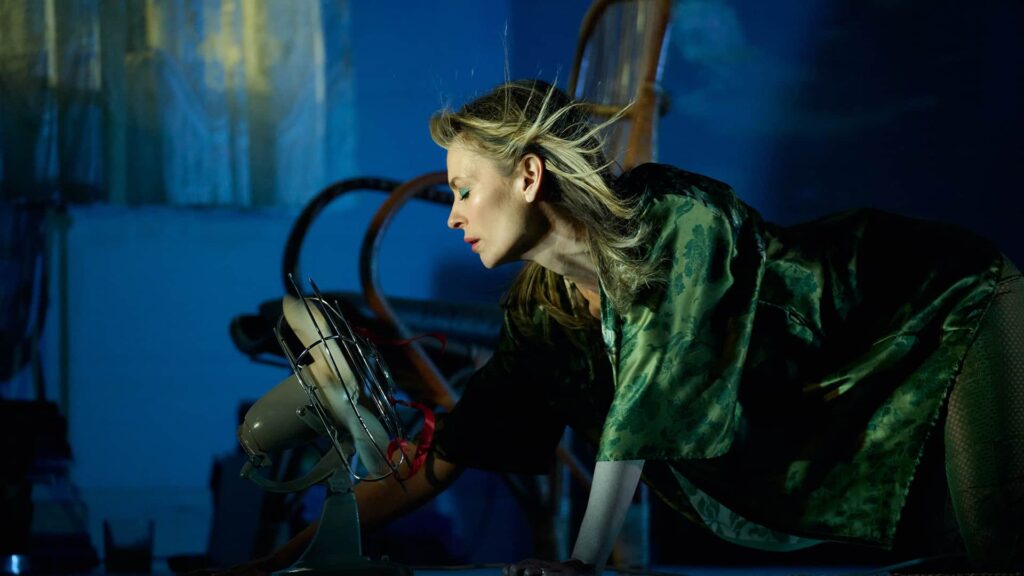
‘Who’s Afraid of Virginia Woolf?’ // Comedy Theatre
‘Who’s Afraid of Virginia Woolf?’ was gripping.
Edward Albee’s ‘Who’s Afraid of Virginia Woolf?’ is one of the most gripping scripts of the 20th century.
‘Who’s Afraid of Virginia Woolf?’ takes place over one emotionally distressing and draining nightcap. It tells the story of a married couple made up of an associate professor in history, George and his wife Martha who is the daughter of the university dean. Their relationship is tumultuous and sadistic, with George playing cruel games against Martha, who retaliates emotionally against him. After a long party, George and Martha invite a young couple, Nick and Honey into their home for a night of drinking and draw them into their anger and agony toward each other.
We are introduced to the two main characters at the back of the audience, where they begin to cackle. This was a brilliant way to introduce them and emphasise the absurdist nature of this performance as I initially mistook them for unruly audience members but found their behaviour extremely unusual. As they walk through the audience, we instantly are introduced to their bizarre dynamic, the pair utterly hate each other yet seem completely dependent on each other. The entire performance takes place in George and Martha’s living room, which barely changes throughout the three-hour run time of this performance.
‘Who’s Afraid of Virginia Woolf?’ was carried by a cast of four. Kat Stewart had the lead role of Martha and gave a multidimensional portrayal that was fuelled by both frustration and angst. Stewart’s performance demonstrated a deep understanding of the script and its historical context, it showcases someone who has researched beyond just watching film adaptations and truly cares about the source material. Emily Goddard captured the sullen and naïve Honey, emphasising her confused state and foreshadowed her perceived future entrapment. Equally brilliant were David Whiteley as George and Howard Zielinski as Nick. Both were brilliant in their portrayal of patriarchal archetypes and were able to emphasise the heavy content of the script in a respectful manner.
The costume design both reflected the era, and Martha’s desire to explore the modern world and its liberation of women. When we were first introduced to Martha, she was wearing conservative hostess clothing, though as the play progressed, her costume became more liberating and modern. Similarly, Nick, whose costume also progressed in such a manner, though instead represented his turn away from hyper masculine behaviour. Honey and George’s costumes did not change and were very accurate representations of the era. The set remained in Martha and George’s living room for the entire performance. Apart from the couple walking home at the beginning, it never transformed location throughout the performance. The living room was an accurate depiction of an older house which had been owned by a couple desperate to keep up with current fashion trends. Great care was used to evoke authenticity and accuracy.
This script was scandalous in its era, containing dialogue that almost led to it being banned, whilst it is still shocking, we are fed a stream of similar content and media. There were times when the script was repetitive, and the only thing in common I have with the characters is that I have a cocktail bar in my living room and that I wish to pursue a career as a history professor. It’s difficult to see myself in this play due to our changing frameworks within society, I feel that I am a polar opposite. My connection with this play completely reinforced my decision to be a feminist. The societal expectations at the time taught women that they must rely on men for their success or happiness. Martha’s focus on her reputation against the expectations of her role. Martha, the daughter of the college dean, married a professor despite deep down wanting to be one and having control over her own career. Societal expectations and the need to carry the family line forced her to marry a high-ranking academic, but when George only was an associate academic, she grew resentful. Women are forced to be dependent on men for their own happiness, this prevents them from accessing the independence to be self-reliant. During the time this play was written and is subsequently set, women were forced to give up their own careers to be subservient and dependent on men. ‘Who’s Afraid of Virginia Woolf?’ can be interpreted as a release of women’s frustrations and a warning towards future generations of women, as shown through Nick and Honey.
Edward Albee’s ‘Who’s Afraid of Virginia Woolf?’ uses heavy naturalism, a theatre movement that intends to replicate real life. It is a marathon performed almost entirely over its three-hour run time which is unusual for contemporary dramatic performances. There are two short intermissions. Absurdism is also present, expressed entirely through examples based in reality through the bizarre behaviours expressed by the two main characters, regardless, nothing deviating from our physical reality takes place. I see this play as a difficult sitting, certainly one that has a lot of memorable parts. Whilst it was certainly scandalous in its day, I find that it makes for poignant viewing today. Contemporary audiences will certainly take a lot away from this performance and it is certainly recommended.
‘Who’s Afraid of Virginia Woolf?’ is playing at the Comedy Theatre from the 29th of June until the 21st of July. For more information visit Ticketek.






